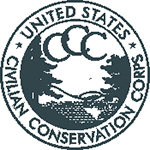History of Colton Point State Park
Colton Point was named in the late 1800s for Henry Colton, a lumberman who supervised harvesting trees in the area.
The park was established from state forest lands purchased in the early 1900s.
Civilian Conservation Corps

Colton Point State Park was developed by the Civilian Conservation Corps (CCC) Camp S-91-PA Painter Run from 1933 to 1936. It opened to the public in 1936.
The CCC’s contributions are still visible today through the five stone and timber pavilions in the park. In 1988, the CCC-built facilities were added to the National Register of Historic Places.
Human Influence on the Pine Creek Gorge
American Indians used the Pine Creek Gorge as a major travel route. Today's Pine Creek Trail follows the same general route as the original path. Just north of the park, at Ansonia, was a seasonal hunting camp called “Big Meadow.”
The lumbering of the native white pine, hemlock, and assorted hardwoods led to the settlement of the area.
Each spring, logs were floated in huge rafts to mills at Williamsport. Lumber from this area helped to make Williamsport the lumber capital of the world in the 1880s.
Hemlock bark was peeled and hauled to several local tanneries to turn hides into leather.
By the 1900s, only a few small areas of native forest were untouched in all of Pennsylvania.
Due to the mass deforestation, massive forest fires, and unregulated hunting and trapping, wildlife populations declined greatly in the commonwealth. White-tailed deer, beaver, and elk were reintroduced to the state in the early 1900s. More recent reintroductions include river otters in 1983 and fishers in the mid-1990s. Bald eagles, once an endangered species, began nesting in the gorge in the late 1980s.
Prior to being a world-class multi-use trail, Pine Creek Trail was an active railroad. The Jersey Shore, Pine Creek and Buffalo Railway Company began in 1883 by carrying timber to the sawmills in Tiadaghton, Cammal, and Slate Run. The railroad also transported coal north to New York State and vast amounts of hemlock bark to several local tanneries for use in the leather industry.
By 1896, the railroad was carrying seven million tons of freight and three passenger trains on daily runs between Wellsboro Junction and Williamsport.
The railroad changed hands several times and was eventually taken over by Conrail. The last train passed through the canyon on October 7, 1988.
Today, the rail line has taken on a new life as a part of the state’s extensive network of railtrails.
In 1968, 12 miles of the canyon were designated a National Natural Landmark by the U. S. Department of the Interior. In 1993, the gorge became a State Park Natural Area, which will protect it in a natural state for future generations. In 1992, Pine Creek was designated a Pennsylvania Scenic River.